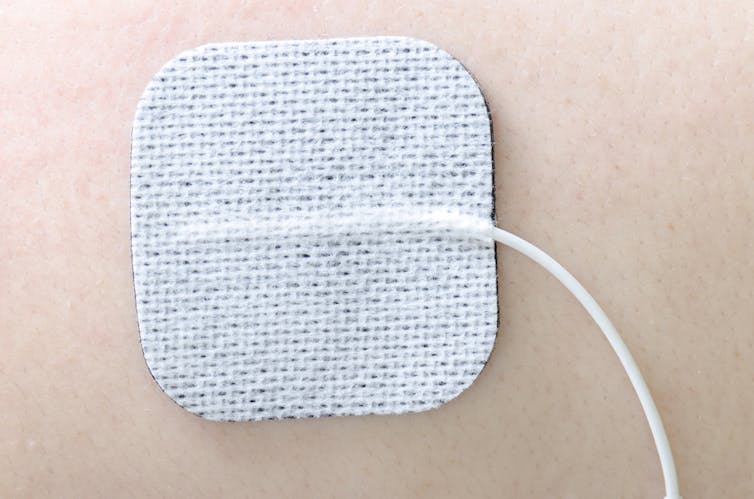If you’ve been on social media recently you might have noticed sponsored posts and ads for a variety of small, portable electrical devices. These claim to manage period or endometriosis pain safely and without drugs.
Most devices have a small box that generates an electrical pulse, and wires connected to sticky pads, which go on your tummy.
So how are these devices supposed to stop your pain? Are they safe? Do they actually work?
Read more: Health Check: are painful periods normal?
They’re mini TENS machines
These devices use “transcutaneous electrical nerve stimulation”, better known as TENS. In other words, they apply small electrical pulses across the skin to stimulate certain types of nerves.
TENS machines are not new. They’ve been around since the 1970s and have been used for a variety of painful conditions, from muscular injuries to pain relief in labour.
However, these latest devices are compact and easy to wear discretely compared to the older models. They’re fairly simple to use, portable, you can use them at home, and they cost around A$50-200.
It’s easy to see why devices like these might be popular. Half of people with period pain say over-the-counter medication such as ibuprofen doesn’t get rid of their period pain. Most people with endometriosis report major issues with getting adequate pain relief.
Read more: From sharp butt pains to period poos: 5 lesser-known menstrual cycle symptoms
How might TENS work?
All TENS-based devices generate small electrical pulses that feel a little like mild electrical shocks. These pulses are transmitted through the surface of the skin via the sticky pads.
You generally place these pads where the pain is. So for period pain that’s usually at or below the level of the belly button but above the pubic region. You can also place the pads on your lower back or even on your tailbone (sacrum). This is because some nerves near your tailbone also affect the pelvic area.

Here’s what we know so far
The exact mechanisms of how TENS works to reduce pain is still unclear. There are likely many different pathways.
First, we need to first talk about different types of nerves. Nociceptors are nerves that send “danger” impulses about actual or potential tissue damage. Sensory nerves in your skin transmit information about things such as touch and pressure.
The gate control theory of pain says the spinal cord has “gates” that can be open or closed. When these gates are open, nerves can transmit these danger impulses up the spinal cord to the brain where they may be interpreted as “pain”. If these gates are closed, these impulses can’t reach the brain as easily.
TENS machines, especially at high frequency (greater than 50 pulses per second), tend to stimulate sensory nerves (the ones in your skin). These sensory nerves also send signals to your brain, but faster than the danger ones.
These sensory signals can close the “gates” at certain parts of the spinal cord. So if the TENS machine can stimulate enough of these sensory nerves in your skin, it will block at least some of these danger impulses from reaching the brain. The fewer danger impulses that reach the brain, the less pain you are likely to feel.

Then there’s the concept of endogenous opioids as pain relief. These are pain relieving chemicals the body makes itself.
TENS machines stimulate the release of these chemicals, with different types of endogenous opioids released depending on the frequency of stimulation.
Read more: Explainer: what is pain and what is happening when we feel it?
So does TENS work?
For period pain
A systematic review in 2022 found four studies looking at TENS to manage primary dysmenorrhea (period pain that occurs without any physical changes in the pelvis).
There was a significant reduction in period pain when high-frequency TENS (more than 50 pulses per second) was compared to sham TENS (where the machine looks the same but doesn’t deliver a pulse).
This is in line with an older Cochrane review that found similar benefits.
Pain relieving effects only tend to last while the device is active.
For endometriosis
Endometriosis is where tissue similar to the lining of the uterus is found outside the uterus, commonly in the pelvis. There is only one study of TENS for pelvic pain due to endometriosis.
This study compared two types of TENS – one using a higher frequency for 20 minutes twice a day, and one using a lower frequency for 30 minutes once per week. Both types used pads placed on the tailbone, and women were told to make the pulses “strong, but comfortable”.
Both types improved pelvic pain, pain after sex, and quality of life, but not period pain. This was a very small study (11 women in each group) and there was no control or placebo group. So we need larger studies with a proper control group before we can be sure if TENS works for endometriosis pain.
Read more: I have painful periods, could it be endometriosis?
Is it safe?
Most studies report no side effects when the pads are used on the abdomen or lower spine.
However, if you turn up the intensity too high it can be uncomfortable. You could also get a rash from the adhesive on the pads.
Read more: First periods can come as a shock. 5 ways to support your kid when they get theirs
Which one to buy?
All TENS machines should allow you to change the intensity (how strong the pulse feels). Some also allow you to change the frequency (how often the pulses happen).
If you are going to use the device occasionally (less than 4-5 days per month) you may just need a device that allows you to change the intensity.
To get the best relief, the machine should be turned up high enough so it delivers noticeable pulses, but is not painful. So you need to find your own comfort level.
For period pain, high frequency (more than 50 pulses per second) shows better results than low frequency (usually 2-5 pulses per second). So make sure the device you’re thinking of buying is either set to a high frequency or you can change the frequency.

For people with endometriosis, it’s a little more tricky. You’ll probably going to want to use the device more often than a few days a month.
Unfortunately, like with taking regular opioid painkillers, with regular TENS use people can become tolerant to its pain-relieving effect, which means it doesn’t work as well as it did when you first started using it.
One possible solution to tolerance is to use mixed-frequency TENS where both high and low frequencies are alternated. You can also slowly increase the intensity level over time.
TENS also doesn’t work well when people are regular opioid users. This is important as people with endometriosis are often using opioid medications to manage their pain. If you are using opioids regularly, high-frequency TENS is likely to be a better choice.

